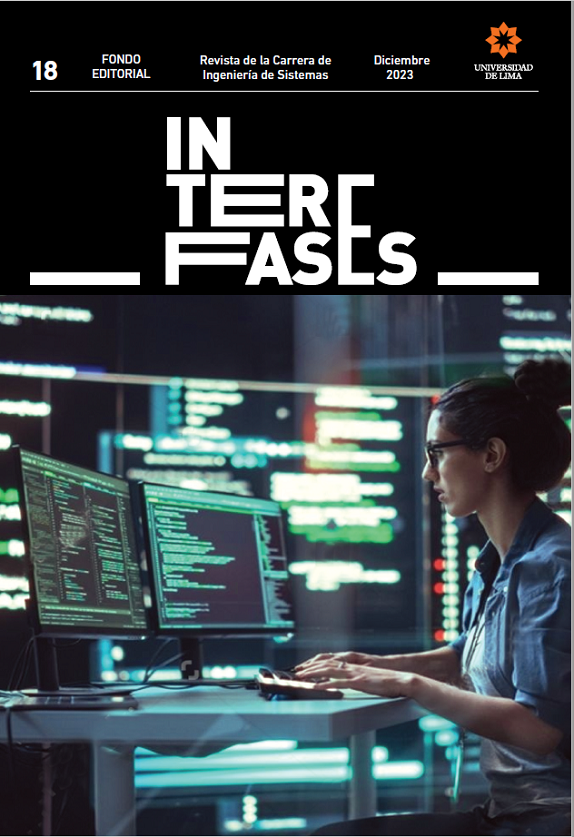Proof of Concept of Touchless Interface on Random Keypad for ATM Shoulder Surfing Mitigation
DOI:
https://doi.org/10.26439/interfases2023.n018.6557Keywords:
touchless interfaces, automated teller machines, shoulder surfing, random keypadAbstract
Financial inclusion in Peru is on the rise, with 56% of adults already having financial products. This has increased the use of ATMs and the risks associated with them, such as shoulder surfing. To mitigate the risk of this attack, a proof of concept of a touchless interface that allows users to enter their PIN securely was developed, proposing an example for use by banking institutions or ATM manufacturers. For this purpose, randomly disordered sequences of numbers from 0 to 9 were generated without repeating them. Then, infrared sensors were implemented to enter the PIN numbers. Mitigation and usability tests were performed with a group of 16 people. The first test showed encouraging results, as the attackers found it difficult to identify the digits entered by the users and only managed to register 25% correctly. Likewise, in the usability tests, an usability average of 78.4375 was obtained, placing the interface in a B+ range, above the threshold of 68 points. Considering this, it is concluded that the proposal meets the objective of allowing the user to enter his PIN securely against shoulder surfing attacks.
Downloads
References
Abhishek, K., Verma Kumar, M., & Prasad Singh, M. (2019). Automated random colour keypad. International Journal of Information and Communication Technology, 15(2), 162-175. https://doi.org/10.1504/IJICT.2019.10018383
Adithya, P., Aishwarya, S., Megalai, S., Priyadharshini, S., & Kurinjimalar, R. (2018). Security enhancement in automated teller machine. Proceedings of 2017 International Conference on Intelligent Computing and Control, I2C2 2017, 2018-January. https://doi.org/10.1109/I2C2.2017.8321773
Agarwal, M., Mehra, M., Pawar, R., & Shah, D. (2011). Secure authentication using dynamic virtual keyboard layout. International Conference and Workshop on Emerging Trends in Technology 2011, ICWET 2011 - Conference Proceedings, Icwet, 288-291. https://doi.org/10.1145/1980022.1980087
Ahmad, A. G. (2013). Arduino as a learning tool. Sensing Technologies for Global Health, Military Medicine, and Environmental Monitoring III, 8723, 872313.
Alsuhibany, S. A. (2021). A Camouflage Text-Based Password Approach for Mobile Devices against Shoulder-Surfing Attack. Security and Communication Networks. https://doi.org/10.1155/2021/6653076
Borsci, S., Federici, S., Bacci, S., Gnaldi, M., & Bartolucci, F. (2015). Assessing user satisfaction in the era of user experience: Comparison of the SUS, UMUX, and UMUX-LITE as a function of product experience. International Journal of Human-Computer Interaction, 31(8), 484-495. https://doi.org/10.1080/10447318.2015.1064648
Bultel, X., Dreier, J., Giraud, M., Izaute, M., Kheyrkhah, T., Lafourcade, P., Lakhzoum, D., Marlin, V., & Motá, L. (2018). Security analysis and psychological study of authentication methods with PIN codes. Proceedings - International Conference on Research Challenges in Information Science, 2018-May, 1-11. https://doi.org/10.1109/RCIS.2018.8406648
Chakraborty, T., Nasim, M., Bin Malek, S. M., Sami, M. T. H. M., Saeef, M. S., & Al Islam, A. B. M. A. (2016). Sporshohin: A tale of devising visible light based low-cost robust touchless input device. Proceedings of the 7th Annual Symposium on Computing for Development, ACM DEV-7 2016. https://doi.org/10.1145/3001913.3001914
Edem Udo Udo, E., Abiso Kabir, A., Yusuff, A. M., & Bukola Simeon, A. (2017). Impact of automated teller machine on customer satisfaction and profitability of commercial banks. IIARD International Journal of Banking and Finance Research, 3(2). http://www.iiardpub.org
Ipsos. (2019, 14 de octubre). Hay 400,000 que sufrieron algún tipo de robo o fraude financiero. Ipsos. https://www.ipsos.com/sites/default/files/ct/publication/documents/2019-10/hay_400000_que_sufrieron_algun_tipo_de_robo_o_fraude_financiero.pdf
Lewis, J. R. (2018). Measuring perceived usability: The CSUQ, SUS, and UMUX. International Journal of Human-Computer Interaction, 34(12), 1148-1156. https://doi.org/10.1080/10447318.2017.1418805
Lewis, J. R., Utesch, B. S., & Maher, D. E. (2013). UMUX-LITE - When there’s no time for the SUS. Conference on Human Factors in Computing Systems - Proceedings, October, 2099-2102. https://doi.org/10.1145/2470654.2481287
Maiti, A., Jadliwala, M., & Weber, C. (2017). Preventing shoulder surfing using randomized augmented reality keyboards. 2017 IEEE International Conference on Pervasive Computing and Communications Workshops, PerCom Workshops 2017, 630-635. https://doi.org/10.1109/PERCOMW.2017.7917636
Montanaro, L., Sernani, P., Dragoni, A. F., & Calvaresi, D. (2016). A touchless human-machine interface for the control of an elevator. CEUR Workshop Proceedings, 1746, 58-65.
Rajarajan, S., Maheswari, K., Hemapriya, R., & Sriharilakshmi, S. (2014). Shoulder surfing resistant virtual keyboard for internet banking. World Applied Sciences Journal, 31(7), 1297-1304. https://doi.org/10.5829/idosi.wasj.2014.31.07.378
Roth, V., Richter, K., & Freidinger, R. (2004). A PIN-entry method resilient against shoulder surfing. Proceedings of the ACM Conference on Computer and Communications Security, 236-245. https://doi.org/10.1145/1030083.1030116
Sevilla-Gonzalez, M. D. R., Moreno Loaeza, L., Lazaro-Carrera, L. S., Bourguet Ramirez, B., Vázquez Rodríguez, A., Peralta-Pedrero, M. L., & Almeda-Valdes, P. (2020). Spanish version of the system usability scale for the assessment of electronic tools: Development and validation. JMIR Human Factors, 7(4), e21161. https://doi.org/10.2196/21161
Shukla, S., Helonde, A., Raut, S., Salode, S., & Zade, J. (2018). Random keypad and face recognition authentication mechanism. IRJET, 5(3), 3685–3688.
Statista. (2023a). Number of automated teller machines (ATMs) per 100,000 adults in Peru from 2005 to 2021. https://www.statista.com/statistics/1079224/peru-automated-teller-machines-atm-penetration/
Statista. (2023b). Number of ATM transactions in selected countries in Latin America in 2019. https://www.statista.com/statistics/823923/number-atm-transactions-latin-america-country/
Still, J. D., & Bell, J. (2018). Incognito: Shoulder-surfing resistant selection method. Journal of Information Security and Applications, 40, 1-8. https://doi.org/10.1016/j.jisa.2018.02.006
Superintendencia de Banca y Seguros y AFP. (2020). Perú: indicadores de inclusión financiera de los sistemas financieros, de seguros y de pensiones - junio 2020. https://intranet2.sbs.gob.pe/estadistica/financiera/2020/Junio/CIIF-0001-jn2020.PDF
Toledo Concha, E., & León Reyes, V. (2023). Financial inclusion in Peru: Appraisal and perspectives. Quipukamayoc, 31(65), 73-84. https://doi.org/10.15381/quipu.v31i65.25882
Yu, M., Zhuge, J., Cao, M., Shi, Z., & Jiang, L. (2020). A survey of security vulnerability analysis, discovery, detection, and mitigation on IoT devices. Future Internet, 12(2), 1-23. https://doi.org/10.3390/fi12020027
Downloads
Published
Issue
Section
License
Authors who publish with this journal agree to the following terms:
Authors retain copyright and grant the journal right of first publication with the work simultaneously licensed under an Attribution 4.0 International (CC BY 4.0) License. that allows others to share the work with an acknowledgement of the work's authorship and initial publication in this journal.
Authors are able to enter into separate, additional contractual arrangements for the non-exclusive distribution of the journal's published version of the work (e.g., post it to an institutional repository or publish it in a book), with an acknowledgement of its initial publication in this journal.
Authors are permitted and encouraged to post their work online (e.g., in institutional repositories or on their website) prior to and during the submission process, as it can lead to productive exchanges, as well as earlier and greater citation of published work (See The Effect of Open Access).
Last updated 03/05/21






